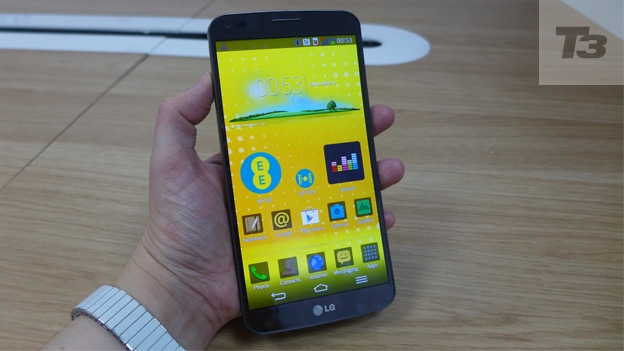LG G Flex review
The LG G Flex is the maker's very first curved Android smartphone

-
+
OLED Display
-
+
Great battery life
-
+
Curved screen great for video
-
-
It’s enormous
-
-
Boring design
-
-
Annoying UI
Why you can trust T3








Are curved screens the future for smartphones? Or are they just a gimmick? Find out in our in-depth LG G Flex review
The first thing to point out here is that the G Flex is not the first curved screen smartphone ever made. Cast your mind back to 2011 and you'll remember the launch of a certain Samsung Galaxy Nexus, that had a curved screen.
It was barely noticeable but it was curved alright and after a few weeks of using it you started to realise that actually, this could catch on. Move five years on and curved screens are now becoming the new '3D', not only are the curves bigger but companies have started using 'science' to back up their reasoning as well.
The LG G Flex is the first of this new wave, boasting a huge 6-inch curved display and unlike its counterpart, the Samsung Galaxy Round, the curve is slightly more conventional, giving it a crescent moon-like appearance.
Going up against big-screened beasts like the Samsung Galaxy Note 3, Sony Xperia Z Ultra and the Nokia Lumia 1520 and cheaper Nokia Lumia 1320, the LG G Flex is designed to make it easier to use that enourmous 6-inch screen.
LG G Flex: Size and build
Picking up the large handset places even more emphasis on its shape and at 177g it feels surprisingly light in spite of its enormous size. Like an elephant in the room (quite literally) we'll need to address that size as it'll affect every single aspect of using it from typing, taking pictures to watching video.
WATCH: LG G Flex hands-on video:
Sometimes it'll be a blessing but as you'll soon discover, more often than not, it's a curse. Build quality is OK with plastic featuring exclusively, enabling the handset to bend if pressed - which means it has some 'give' so that if you sit down with it in your pocket, it should be safe from damage.
On the back there's LG's much trumpeted 'self-healing' material. In reality it'll survive keys and coins with the scratches admittedly disappearing after a few hours. Anything more significant and that mark is there to stay.
The design is almost identical to the LG G2, which means that while it isn't ugly, the G Flex's design isn't particularly inspiring.
LG G Flex: Screen
The LG G Flex sports a 6-inch POLED 1280x720p curved display. As with any new technology you take baby steps so at present this is not a Full-HD display and that 'P' stands for 'Plastic' so no Gorilla Glass here either.
The good news is that while you may notice some pixilation, the colours look fantastically rich and contrast levels are great, you'll also find that the plastic screen will be far less prone to cracking although be on the lookout for rogue keys.
The bad news is that it's just too big a phone, especially with a display that isn't Full-HD. LG has compensated by providing a myriad of features to allow 'one-handed' usage like slanting a smaller keyboard to one side of the screen but the sheer size of the device does make one-handed use become a desperate balancing act between finishing your message and the phone forcibly removing itself from your hand.
LG claims that the curved screen isn't just for better viewing angles it also makes the phone easier to hold. Does it? No. On a smaller device we'd agree but at this size it becomes a moot point.
So what's the curve actually good for then? Viewing angles (apparently), by curving the screen you create a more immersive experience and we have to admit, while watching video content the experience was improved. Of course it helps that the screen is a whopping 6 inches.
LG G Flex: Features
What's actually appearing on that screen is LG's skinned version of Android 4.2.2. It's identical to the G2 along with the plethora of extra features like the ability to split apps across the screen and Slide Aside which lets you easily swap between open applications.
While many of the features feel like unnecessary clutter, some features like Quick Remote and KnockOn are genuninely useful. QTheater enables you to pinch out from the lock screen and open instant access to movies, images and YouTube. The layout has been designed for instant access to all your media making full use of that huge display.
Quad-core processors have their uses, one of which is being able to show two apps running side by side. Open Dual-Window, choose two apps then flick them to either side of the screen then share and swap content between the two to your heart's content.
You're looking at almost identical hardware specs to the LG G2 including 2GB RAM, a blistering 2.26GHz quad-core processor and non-expandable storage of 32GB. It's nippy to say the least and of course the lack of a Full-HD display does nothing but enhance that with apps loading quicker and running much more smoothly.
LG G Flex: Battery
The key difference is the battery though with the Flex getting a custom-built 3,500mAh curved unit. That's a step up from the G2: factor in the lower-resolution display the Flex has and you're looking at some seriously impressive run time.
LG G Flex: Camera
On the back you'll find the same camera as the LG G2, a 13MP sensor with some neat software features including the ability to 'zoom' in on specific audio as well as the ability to zoom in and track a specific object while also recording video.
They require extremely steady hands and very slow movement so if you're hoping to track someone at a gig, we'd think again. Elsewhere the G Flex's camera could do with improvements; the software is slow and lag-heavy while performance in low-light could do with some work.
The G Flex is also one of the first smartphones with 4K video recording, although you'll need to play it back on a 4K display like the Panasonic TX-L65WT600 to get the full effect, as the Flex's non full-HD screen doesn't do it justice.
LG G Flex: Verdict
The verdict on curved screens is nowhere near final, manufacturers are still gauging public opinion and as such there'll be a lot of trying and testing. As a first effort the LG G Flex is a curious proposition requiring absolute faith in its USP.
Have even a slither of doubt though and you'll notice the potentially decision-changing flaws like the size, lack of Full-HD and average camera performance. If we had to bet money we'd say that ultimately curved screens will need to be a compromise of portability and also practicality blending the design to make it better to hold in the hand whilst accepting that making it too big will just become unusable.
The G Flex feels like LG is putting its finger up to the wind - with its 'self-healing' back and curved display it hints suggestively at a futuristic device that turns up when you don't need it and is impervious to harm.
We'd pay big for that phone, but unfortunately this isn't it. If, however, you're a curve-loving early adoptor with your heart set on a more expensive but undulating G2, dive right in.
LG G Flex release date: Out now
LG G Flex price: £530
Sign up to the T3 newsletter for smarter living straight to your inbox
Get all the latest news, reviews, deals and buying guides on gorgeous tech, home and active products from the T3 experts
Thomas Tamblyn studied journalism at the University of Westminster, where he was a contributing presenter at the award-winning Smoke Radio station. He then moved to T3.com as a Staff Writer where he proceeded to write news, reviews and features on topics such as phones, electric vehicles, laptops, gaming, streaming services, headphones, tablets future tech and wearables.
-
 Forget burpees – this 20-minute workout boosts your metabolism with no jumping
Forget burpees – this 20-minute workout boosts your metabolism with no jumpingGet your heart pumping with this no-jump workout
By Bryony Firth-Bernard Published
-
 Rituals unveils dreamy new collection in first-ever AI collaboration
Rituals unveils dreamy new collection in first-ever AI collaborationIt's a first from the luxury cosmetics brand
By Lizzie Wilmot Published
-
 Trail runners have a new reason to get excited about Saucony’s Peregrine lineup
Trail runners have a new reason to get excited about Saucony’s Peregrine lineupTrail runners loved the Peregrine 14, but will they love the new version even more?
By Matt Kollat Published